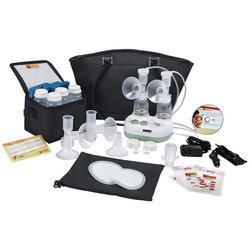If you’re a new mother who is primarily breastfeeding and looking to store breast milk for the baby, then you need to know a few basic things about breast pumping.
Let’s get started with some quick tips on breast pumping:
1. Try and pump milk in the morning. Most women tend to have the maximum amount of milk in their breasts right in the morning. So this is a good time to pump.
2. You can pump in between breastfeeding too. This can be done anywhere between 30 to 60 minutes after nursing. You could also do it an hour prior to feeding. This will leave sufficient milk for the infant in the next feed.
3. In case the baby requires a breastfeed just after you have pumped milk, you can go ahead and do so. You might find that your baby is patient and can feed longer in order to get the desired amount of milk.
Using a breast pump
To use an electric breast pump, you will need to place a breast shield over your nipple before switching the machine on. It will then automatically extract your milk out (via suction) and pour it into the attached container. Breast shields or phalanges usually come with the pump.
Manual breast pumps also makes use of a flange. However, you need to extract your milk using a squeezing technique or you could use your hand to pull a plunger instead of depending on a motor. It will take about 10 to 15 minutes to complete pumping both the breasts using an electric breast pump; however, a manual breast pump could take up to 45 minutes.
Breast pump accessories
New moms who are actively breast pumping require different types of accessories (for pumping, storage and transport) to make the pumping sessions smooth and efficient. Safe storage of breast milk is critical too; hence you need to consider getting a good breast milk storage system like glass containers or bags.
If you are pumping milk somewhere outside of your home, then you might need a breast pump bag which can accommodate all your essentials and extras such as keys, cell phone, wallet, water etc.
Various breast pump manufacturing companies also offer accessories for pumping, storing and transporting milk along with the pump. If these accessories don’t already come with your pump, then you might have to purchase them separately.
Health and hygiene related to breast pumping
It is possible for humans to unknowingly harbor infectious diseases. Therefore, the sharing of personal care products such as a single-user breast pump is not a good idea. Being a biological substance, breast milk could carry CMV and HIV. These viruses could accidently be transmitted to the baby. In addition to this, if a mother has cracked or bleeding nipples, the blood will naturally come into contact with the external parts of the pump. Even if you wash the pump well, it is still possible for the viruses and bacteria to get transmitted.
Article Reviewed By Crystal Ibetoh MD, MBA reviews each article and ensures the accuracy of the health information. Dr. Ibetoh has strong medical interests in women's health and preventative medicine. She is also a mother of three and uses her medical expertise in addition to personal experience to provide advice about breastfeeding.
*The information provided on this site is intended for your general knowledge only and is not a substitute for professional medical advice or treatment. Please consult your healthcare provider with any questions or concerns you may have regarding breastfeeding.*

Both mother and child can reap numerous benefits from exclusive breastfeeding for the initial six months... Read More

Isn’t it everyone’s dream to burn all those calories while sitting comfortably on their lounge chair... Read More
